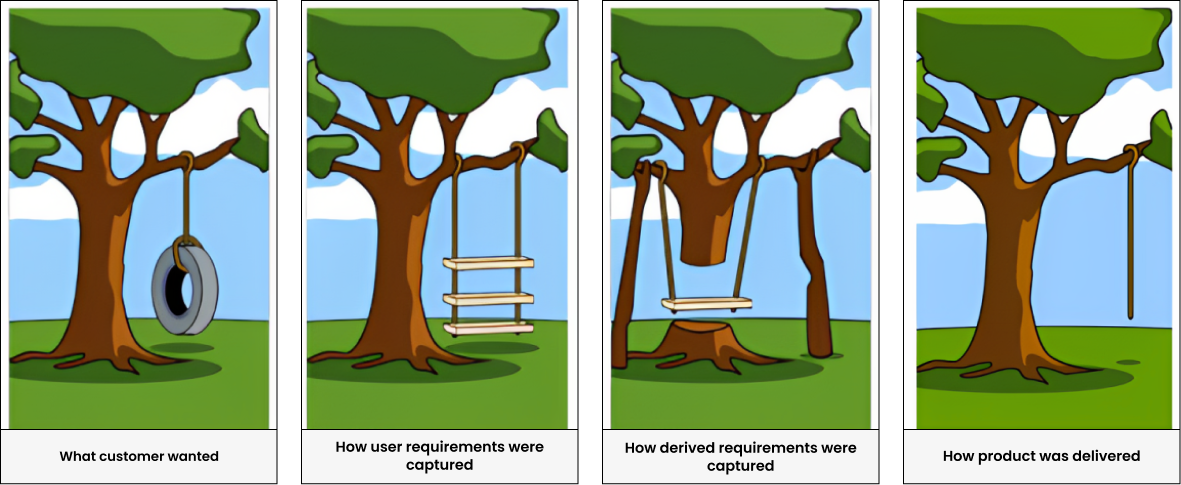- Requirements Management is a set of powerful techniques for capturing, analyzing, prioritizing, and agreeing on requirements to ensure that engineering teams always have up-to-date and approved requirements.
- It helps to reduce errors by keeping track of changes in requirements and promoting effective communication with stakeholders from the start of a project to the end of the engineering lifecycle.
- Ultimately, the purpose of requirements management is to ensure that product development goals are achieved in a timely and cost-effective manner.
Why Do Requirements Processes Often Fail To Deliver the Expected Business Results?
Cause :
- The lack of a unified and fully defined requirements engineering process.
- Use of general purpose applications or multiple authoring tools.
- Inconsistent requirements data.
- Lack of communication across business and functional silos.
- Individual groups interacting with requirements that are relevant to their functional process.
Solution :
- Requirements should be the unifying force that binds all teams together and keeps them focused on delivering value to customers throughout the entire product development cycle, from conception to completion.
- All engineering disciplines, including mechanical, electronic, and software, must work in tandem to ensure that the requirements are met and that customers receive a product that meets their needs.

What Are “Requirements”?
A requirement is “a singular documented need of what a particular product or service should be or do” such as:
- Functional Requirements describe certain behaviors (or functions) of “what the system shall do”
- Non-Functional Requirements describe how well these behaviors (or functions) should be performed,
Requirements guide the entire development of a system. These Requirements:-
- Originate from numerous sources
- Should be cohesive, complete, consistent, correct, current, feasible, unambiguous and verifiable
What is ‘Requirements’ for Successful Requirements?
- It is the agreement between all stakeholder about process of requirement definition
- These are tools capable of capturing perceptions, knowledge and communication
- Central Repository
- Capture all requirements and related data such as discussions and comments
- Allowing access to all involved parties.
- IT infrastructure enabling collaboration
- Internal and external collaboration
- Support of different formats suitable for business and technical people
- Text, graphics, tables, diagrams
- Ability to enforce a defined workflow
- Including approvals, clearance, etc.
- Shared Glossaries
- Reduce ambiguity on terminologies
- Ability to enforce a established Change-Management process
They aid in
Structured Approach for a Good Requirements Management
- Break-down requirements into hierarchies
- From high-level architecture to low-level design
- From the entire system down to the mechanical, hardware and software disciplines.
- Manage relations between requirements
- From one level to another and in between.
- Add attributes to requirements
- Author, History, Priorities, Risks, etc.
- Make requirements visible across the entire lifecycle
- Provide access to requirements to all participants in the process.
Also Read: 9 Success Factors for Effective Requirements Management
Unmanaged Requirements are Costing Your Business
Requirements issues drive excessive rework, delays, poor quality, and project failures.
Requirements Rework :
- Errors, detected late in the Maintenance phase can cost up to 200 times more than detected early in Requirement Analysis phase
- More than 40% of development budget can be consumed by poor requirements
Project Impacts :
- 41% of projects fail to deliver the expected business value and ROI
- 49% of projects overrun original estimates
- 28% of projects on time and on budget
Project Delays :
- Being late to market by 6 months or more will cost organizations 33% of the 5-year ROI5
Having a Requirements Management Plan (RMP) is critical to the success of a project because it enables engineering teams to control the scope and direct the product development lifecycle. Requirements management software provides the tools for you to execute that plan, helping to reduce costs, accelerate time to market, and improve quality control
The Proper Requirements Management Plan
Requirements Management Process through Systems Engineering V-Model
A typical requirements management process complements the systems engineering V-model through the following steps:
- Collect initial requirements from stakeholders
- Analyze requirements
- Define and breakdown requirements
- Capture additional information along with requirements
- Prioritize requirements
- Agree on and approve requirements
- Trace requirements to implementation items
- Assess impact of changes
- Communicate the change to involved parties and stakeholders
- Verify requirements
- Version requirements
- Make requirements accessible to all participants involved
Using a requirements management solution helps to streamline the process so you can optimize your speed to market and expand your opportunities while improving quality.
Digital Requirements Management
- Digital requirements management (DRM) is an invaluable tool for getting everyone on the same page, including contractors, suppliers and customers.
- It provides a secure, central location to store requirements, while improved collaboration, transparency and agility ensure that standards and compliance are met.
- Furthermore, DRM’s inbuilt reporting capabilities allow for tracking of the project’s status. In sum, DRM is a powerful tool for businesses of all sizes.
- Using AI, engineering teams can more easily flag poorly written, incomplete and ambiguous requirements while receiving real time coaching on how to improve them.
- By adding AI to your requirements management strategy, you can strengthen the quality of your requirements while reducing errors and costs.
End-to-End Lifecycle Traceability with Requirements Management
- Traceability is the key to compliance
- Initial requirements will be decomposed, which creates traceability relationships.
- Other relationships can also be traced such as “consists of”, “verifies”, etc.
- Traceability must be enforced in order to ensure consistency and completeness.
- Traceability from customer requirements through product development to test and delivery enables organizations to:
- Know which requirements are implemented and tested vs. those which are not
- Manage and defend against scope creep.
Change Management Process
- Changes to requirements are inevitable.
- Requirement Change Requests (RCR) can occur as early as the requirement elicitation phase, or as late as product development or maintenance phase, and thus a process for proposing and managing changes will ensure consistently and in a controlled manner.
- The change management process is important for ensuring that changes are implemented smoothly and without issue
Variant Management
Variant management is the process of managing different variants of a product or system, which may share some common features and functions but also have unique features that distinguish them from one another. In the context of engineering and product development, variant management involves defining, documenting, and controlling the different configurations of a product, as well as managing the relationships and dependencies between them. This is important for ensuring that products are designed and produced efficiently, effectively, and with the necessary level of quality and consistency. Variant management is often used in industries such as automotive, aerospace, and manufacturing, where products may have a large number of possible configurations or options.
Some potential benefits of variant management in requirements management include:
- Improved efficiency
- By managing requirements for different product or system variants in a systematic way, variant management can help reduce duplication of effort and improve overall efficiency in the development process.
- Increased agility
- With effective variant management, development teams can more easily and quickly adapt to changes in market demands or customer requirements by leveraging existing requirements and building on top of them.
- Better quality
- By managing requirements more effectively, variant management can help ensure that product or system variants meet the necessary quality standards and requirements.
- Reduced costs
- By reusing existing requirements and building on top of them, variant management can help reduce development costs associated with creating new requirements from scratch.
- Better traceability
- With effective variant management, it becomes easier to trace requirements across different product or system variants, making it easier to manage and maintain different versions of the product or system.
Best Practices of Writing Good Requirements
AI in Requirements Management
- Using AI, engineering teams can more easily flag poorly written, incomplete and ambiguous requirements while receiving realtime coaching on how to improve them
- By adding AI to your requirements management strategy, you can strengthen the quality of your requirements while reducing errors and costs.
Benefits of Good Requirements Management
Provides Query attributes to find specific properties
- “How many requirements are listed as high risk?”
- Before change is committed.
- “Which detailed requirements has no relation to a high-level user requirement?”
- “Which higher level requirement has no lower-level requirement?”
- “What lower-level requirements are affected if a high-level requirement changes?”
Using traceability reports for checking dependencies.Finding “missing” linksCoverage analysisImpact analysisKeep traceability
- For each increment, if you develop incrementally with concurrent phases
- For each variant, if you manage variants and product lines
Dig Deeper: The Role of Requirement Management Services
Requirements Engineering For Quality Management
Quality Management Needs Strong Linkages to Requirements
Requirements are the input for all quality and test specifications like
- Functional Requirement define “What” the test object shall do
- Non-Functional Requirements define “How well” the test object shall do it.
Quality Management linked to Requirements Management
- Incorporates requirements in test- and quality plans.
- Relates test cases, test suites, test execution and test result with requirements.
- Shows which requirements are tested and which are not.
- Provides traceability between and within hierarchies of requirements and tests.
IBM Engineering Requirements Management DOORS Next for Quality Management
This is a single platform for managing requirements so your teams can work more effectively across disciplines, time zones, and supply chains.
It is useful in :
- Collaboration : Clarity across teams by establishing a single source of truth
- Traceability : Connect requirements with tests, system architecture and your plan
- Change Management : Understand impact of changes and track changes
- Transparency : Customizable dashboards and reports for an easy overview
- Optimization : Assess clarity and testability using pre-trained AI models

With IBM Engineering Requirements Management DOORS Next, you can
- Create or import requirements
- Link requirements and track traceability
- Organize requirements in modules and components
- Exchange and export requirements
- Review requirements
- Version and baseline requirements
IBM Requirements Quality Assistant
The requirements model, designed to be in accordance with the INCOSE Guide for Writing Requirements, is pre-trained to detect 10 quality issues, including unclear actor or user, compound requirement, negative requirement, escape clause, missing units, missing tolerances, ambiguity, passive, incomplete requirements, and unspecified quantities. This model provides a consistent and reliable approach to assessing the quality of requirements.
Contact MicroGenesis to know more about Requirements Management using IBM Engineering Requirements Management – DOORS Next




